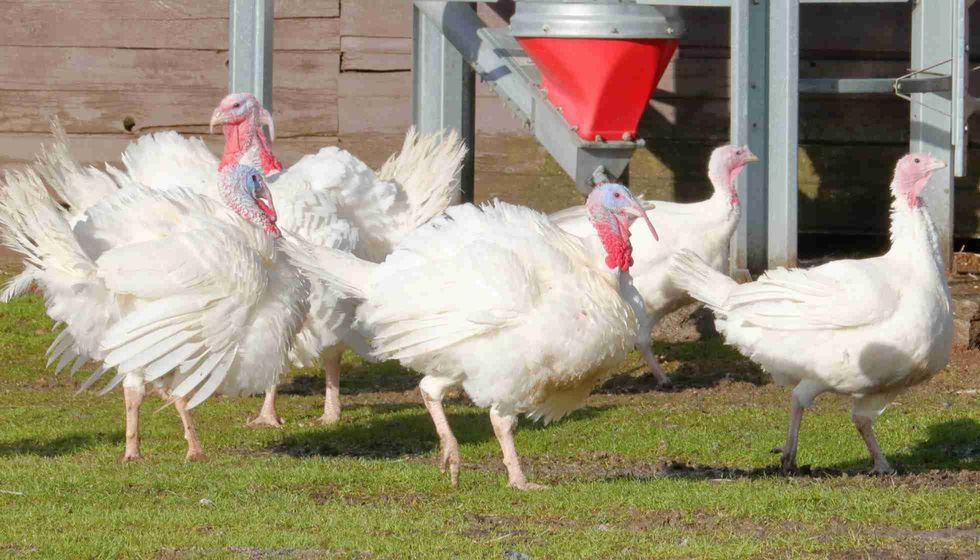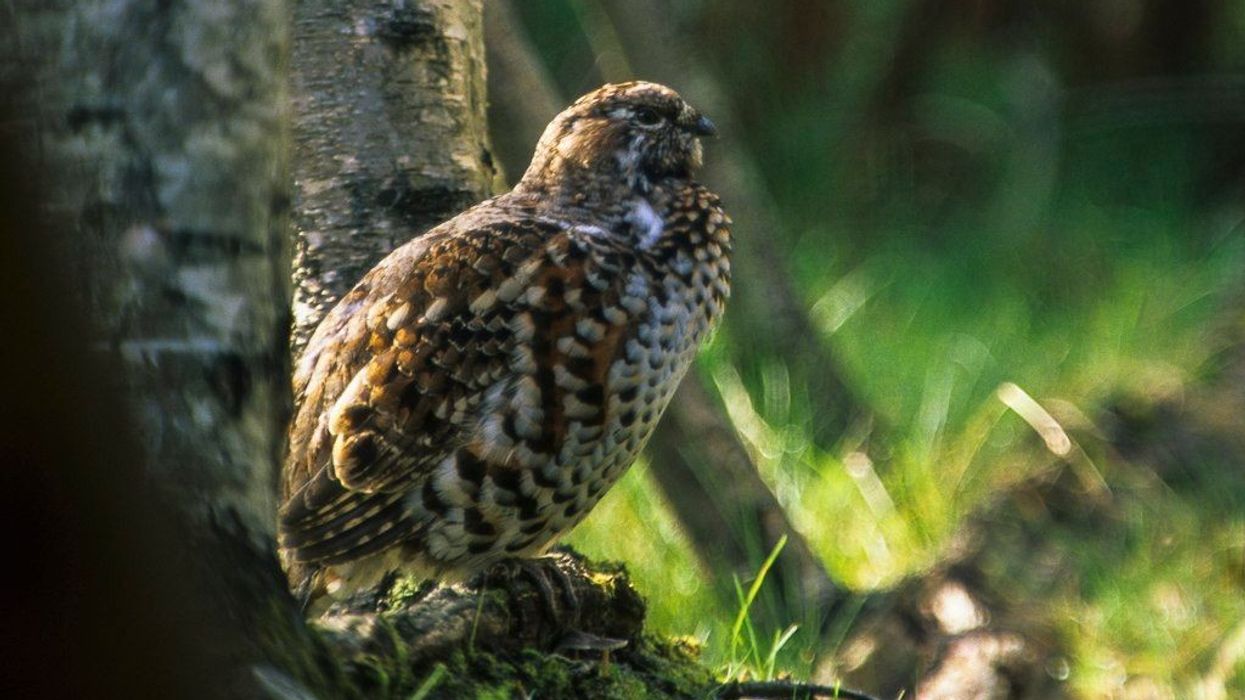Turkeys are popular in the United States, and the White Holland, with its stunning snow-white body, is a rare variant. The White Holland turkey was introduced to the United States in the 1800s and was officially recognized by the American Poultry Association in 1874.
While the name suggests Dutch origins, the White Holland is a breed that originated in America from the broad-breasted bronze variety, as confirmed by organizations like the American Poultry Association.
When the White Holland turkey birds were reintroduced into the United States, it quickly became a market favorite because it matured faster despite being smaller in size than the bronze breed.
This turkey breed has a beautiful appearance with a white frame and red head. The White Holland is known for its hardiness and thus requires less maintenance.
Researchers began crossbreeding the White Holland turkey and the broad-breasted bronze in the 1950s to create a large-sized white-feathered turkey variant. The broad-breasted white turkey is the name given to the crossed variant.
Since its introduction, the broad-breasted white turkey has surpassed the popularity of the White Holland turkey among breeders due to its larger size and faster growth. This resulted in a decline in the population of White Hollands, which was listed as threatened by the Livestock Conservancy in the United States.
Without much ado, let us get straight to the point. Read on to learn more about the domestic White Holland turkey facts. For more info, you can take a look at greater sage grouse and leghorn chicken.
Holland Turkey Interesting Facts
What type of animal is a Holland turkey?
White Holland turkeys are rare, heritage birds that are commercially produced for meat throughout the U.S. The White Holland turkey status is threatened as per the Livestock Conservancy.
What class of animal does a Holland turkey belong to?
The White Holland is a docile bird that belongs to the turkey family in the class of Aves.
How many Holland turkeys are there in the world?
Unfortunately, due to its questionable early heritage, the record of how many White Holland turkeys are there in the world is not known.
Where does Holland turkey live?
The White Holland turkey is a domestic bird that can be found in poultry farms, where farmers breed them for their meat.
What is Holland turkey's habitat?
The White Holland turkeys can survive in any kind of climate; hence, they have a habitat that stretches from Europe to the U.S. This domestic turkey breed can be found in countries such as Austria, Holland, and England in Europe, as well as North America in the United States.
Because its population has declined significantly over the years, breeders breed white turkeys throughout America primarily for conservation and exhibition purposes.
Who do Holland turkeys live with?
Generally, this variety of turkey breed used to be produced commercially for meat at poultry farms. The birds are kept in mixed flocks of toms and hens to maximize egg production. Due to it being listed as threatened, the White Holland turkey breed is now primarily bred by exhibition breeders.
Residing on commercial and private farms, they may be brought up around other livestock like cattle, chickens, and so on. This turkey breed is comfortable around humans with its temperament.
How long does a Holland turkey live?
Again, as they were earlier raised for producing meat in commercial meat farms, we do not know the lifespan of this breed.
How do they reproduce?
The White Holland turkey breeds easily provided that you keep a good ratio of toms and hens in the flock. One well-bred tom can produce around 8-10 eggs.
What is their conservation status?
In the U.S., the White Holland turkey is listed as threatened by the Livestock Conservancy. Their status has not been evaluated by the International Union for Conservation of Nature or the IUCN.
Holland Turkey Fun Facts
What do Holland turkeys look like?
The White Holland turkey is a striking bird with a snow-white plumage. Its red to bluish head contrasts perfectly with the white feathers. Its beak is pink, and the beard is black in color.
Other physical features like throat and wattles, shanks, and toes have a pinkish white hue. The eyes of authentic turkey Holland are blue, but many also have brown eyes.
It is relatively smaller in size compared to other turkey breeds like the broad-breasted white. The White Holland turkey is characterized by small breasts and short legs. The eggs of the White Holland turkey are large in size and pale cream in color.

How cute are they?
Due to their docile temperament and white feathered appearance, these birds can be described as lovable and cute. Being rare and a heritage variety, the White Holland turkey, is now produced for exhibition purposes with their pinkish white throat and wattles. However, their appearance and feathers on the breasts and other body parts are different from ocellated turkeys.
How do they communicate?
Holland turkeys, like most domestic turkeys, gobble or call out to communicate. However, when in large groups, they can peck each other.
This is because domestic turkeys do not like outsiders, and when they are in large groups, it is difficult for them to remember which turkey is part of the group and which turkey is an outsider. This can result in fierce fights, which can even lead to the death of a turkey.
How big is a Holland turkey?
The White Holland turkey is smaller in size compared to the broad-breasted white turkey. The turkey White Holland has smaller breasts and short legs.
How fast can a Holland turkey fly?
Turkeys can generally fly at a speed of 40-50 mph (64.3-80.4 kph).
How much does a Holland turkey weigh?
On average, the market weight of White Holland turkeys ranges anywhere between 16-25 lb (7.2-11.3 kg). Some well-fed toms can weigh up to 33 lb (15 kg) and hens up to 20 lb (9 kg). The birds are not as heavy as the broad-breasted white turkey but are similar to wild turkeys and eastern wild turkeys in weight.
What are the male and female names of the species?
The male variety of White Holland turkey is known as a tom, and the female variety is called a hen.
What would you call a baby Holland turkey?
White Holland turkey babies can be referred to as a chick or poult.
What do they eat?
The White Holland turkey, which is claimed to have originated from the European part of the world, requires a higher protein feed requirement than other livestock such as chickens. White Holland turkey poults require approximately 28 % protein, whereas adults require 20 % protein in their diet.
To achieve the optimum marketing size in six months, breeders would need to feed 100 lb (45.3 kg) for a tom and 60 lb (27.2 kg) for a hen.
Breeders advise on using chick starter feeds to feed poults in the first six weeks. While commercial feeds can be fed to White Hollands but homemade feeds are recommended more by breeders. White Holland turkeys whose beak is pink also require clean drinking water for healthy growth and development.
Are they poisonous?
No, the white turkey is not poisonous. The White Holland is recognized among breeders for meat production and consumption.
Would they make a good pet?
Yes, the White Hollands could be good pets. White Hollands are known for their calm and friendly temperament. However, because White Hollands are large birds, they would require ample space to be raised comfortably.
Depending on the availability, you can get either an adult White Holland or a poult. The price of the White Holland poult would be lower as compared to the mature White Holland turkey breed. It is important to ensure that the poult is healthy and active before the purchase.
While mature White Holland turkey is easy to care for due to its characteristic hardiness, you need to be careful when raising baby White Holland chicks. White Holland turkeys need to be fed on time and be given all the necessary vaccinations to avoid disease and infections.
Did you know...
White Hollands, due to their weight, have a tendency to break their eggs when moving around.
Blackhead is the common health issue found in White Holland turkeys.
What's the difference between Holland turkeys and Royal Palm turkeys?
White Holland turkeys are a commercial meat-bred variety. White Holland turkey can weigh up to 25 lb (11.3 kg) and has snow-white plumage. The White Holland is well-known for being a docile turkey breed that is also simple to raise.
Royal Palm turkeys, on the other hand, are primarily bred for ornamental purposes. This is due to the turkey's eye-catching black and white plumage. The breed is lighter in weight, with a typical Royal Palm weighing between 10-20 lb (4.5-9 kg).
Therefore, when it comes to Royal Palm turkey vs. Holland turkey, both turkey breeds have their own defining features.
Can White Holland turkeys breed naturally?
Yes, White Holland turkeys can breed naturally. If the White Holland turkey is fed optimally and provided a good environment to grow then, the White Holland turkey can produce at least 10 eggs.
Here at Kidadl, we have carefully created lots of interesting family-friendly animal facts for everyone to discover! For more relatable content, check out these Senegal parrot facts and Cooper's hawk facts for kids.
You can even occupy yourself at home by coloring in one of our free printable lovebird coloring pages.










